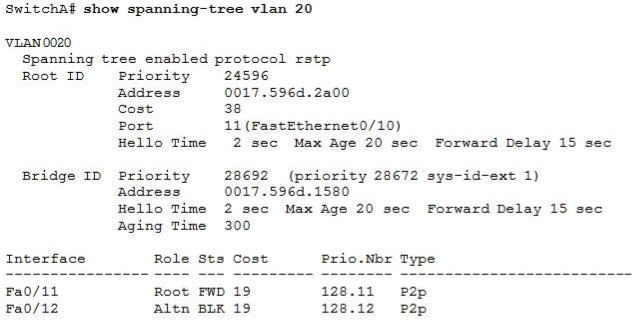ICND2 – RSTP Questions 2
[am4show have=’p2;’]
Premium Member: You can test your knowledge with these questions first via this link.
[/am4show]
Question 1
[am4show have=’p2;’]Refer to the exhibit. Given the output shown from this Cisco Catalyst 2950, what is the most likely reason that interface FastEthernet 0/10 is not the root port for VLAN 2?
Switch# show spanning-tree interface fastethernet0/10

A. This switch has more than one interface connected to the root network segment in VLAN 2.
B. This switch is running RSTP while the elected designated switch is running 802.1d Spanning Tree.
C. This switch interface has a higher path cost to the root bridge than another in the topology.
D. This switch has a lower bridge ID for VLAN 2 than the elected designated switch.
Answer: C[/am4show]
Question 2
[am4show have=’p2;’]Which option describes how a switch in rapid PVST+ mode responds to a topology change?
A. It immediately deletes dynamic MAC addresses that were learned by all ports on the switch.
B. It sets a timer to delete all MAC addresses that were learned dynamically by ports in the same STP instance.
C. It sets a timer to delete dynamic MAC addresses that were learned by all ports on the switch.
D. It immediately deletes all MAC addresses that were learned dynamically by ports in the same STP instance.
Answer: D[/am4show]
Explanation
Rapid PVST+—This spanning-tree mode is the same as PVST+ except that is uses a rapid convergence based on the IEEE 802.1w standard. To provide rapid convergence, the rapid PVST+ immediately deletes dynamically learned MAC address entries on a per-port basis upon receiving a topology change. By contrast, PVST+ uses a short aging time for dynamically learned MAC address entries.
Question 3
[am4show have=’p2;’]Which port state is introduced by Rapid-PVST?
A. learning
B. listening
C. discarding
D. forwarding
Answer: C[/am4show]
Explanation
PVST+ is based on IEEE802.1D Spanning Tree Protocol (STP). But PVST+ has only 3 port states (discarding, learning and forwarding) while STP has 5 port states (blocking, listening, learning, forwarding and disabled). So discarding is a new port state in PVST+.
Question 4
[am4show have=’p2;’]Which command enables RSTP on a switch?
A. spanning-tree mode rapid-pvst
B. spanning-tree uplinkfast
C. spanning-tree backbonefast
D. spanning-tree mode mst
Answer: A[/am4show]
Question 5
[am4show have=’p2;’]Refer to the exhibit. Which statement is true?

A. The Fa0/11 role confirms that SwitchA is the root bridge for VLAN 20.
B. VLAN 20 is running the Per VLAN Spanning Tree Protocol.
C. The MAC address of the root bridge is 0017.596d.1580.
D. SwitchA is not the root bridge, because not all of the interface roles are designated.
Answer: D[/am4show]
Explanation
Only non-root bridge can have root port. Fa0/11 is the root port so we can confirm this switch is not the root bridge -> A is not correct.
From the output we learn this switch is running Rapid STP, not PVST -> B is not correct.
0017.596d.1580 is the MAC address of this switch, not of the root bridge. The MAC address of the root bridge is 0017.596d.2a00 -> C is not correct.
All of the interface roles of the root bridge are designated. SwitchA has one Root port and 1 Alternative port so it is not the root bridge -> D is correct.


any explanation for Q1 please
On the first set of RSTP questions, The first question that you get explains every well why the cost makes it an altn
Q5
Answer D:
SwitchA is not the root bridge, because not all of the interface roles are designated
Explanation says:
All of the interface roles of the root bridge are designated.
How can answer D be correct??
@Mo
let me rephrase it this way it will probably make sense to you.
All interfaces roles of (a) root bridge are designated. However; SwitchA has one Root port and 1 Alternative port so it is not the root bridge -> D is correct….